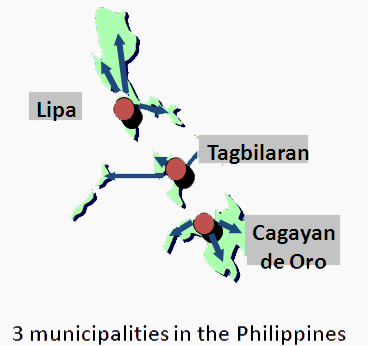Whilst the Philippines already had a very strong national Sustainable Development and LA21 agenda by the late 1990's, the Department of Environment and Natural Resources requested SCP-Asia support in 1998 to help localise in cities through application of the Environmental Planning and Management (EPM) approach, and at the same time to support the decentralization efforts of the Department by creating City Environment and Natural Resource Offices that would complement their Community (or District) ENROs. The League of Cities of the Philippines (LCP) was invited as an implementing partner to document the experiences and synthesise the lessons learned for policy learning and national application.
Support from the United Nations Development Programme (UNDP) enabled application and adaptation of the EPM approach in three demonstration cities; Lipa, Tagbilaran and Cagayan de Oro - one chosen for each main island group - , with project support anchored in different city agencies to test alternative ways of institutionalising the approach within Local Government Units (LGUs): The Mayor's Office (Tagbilaran), City Planning and Development Office (Lipa), and a new (City-ENRO) unit based on solid waste management (Cagayan de Oro) this was the most pressing environmnetal issue.
Most recently, in an attempt to further institutionalize the lessons learned, SCP-Asia has partnered with the Department of Interior and Local Government (DILG), the University of the Philippines School of Environment and Regional Planning (UP-SURP), as well as the Asia Institute of Management (AIM) to support LA21 up-scaling in Cagayan de Oro,Tagbilaran and Lipa respectively, through "action learning", to dissemination of experiences to neighbouring LGUs and to integrate the documented cases and lessons learned into their curricular to "better" educate urban planners in sustainable urban management.
* Click on the map for detailed information on each city





















